|
FAQs about Caryophyllid Coral Disease, Pests, Predation
12
Related Articles:
Coral Pests and
Disease; pests, predators, diseases and conditions by Sara
Mavinkurve, Caryophyllid
Corals, Elegance Coral,
FAQs on Euphylliid Disease:
Caryophyllid Disease 1,
Caryophyllid Disease 2,
Caryophyllid Disease 3,
Caryophyllid Disease 4,
Caryophyllid Disease 5,
Caryophyllid Disease 6,
Caryophyllid Disease 7,
Euphylliid Health 8,
Euphylliid Health 9, Euphylliid Health 10,
Euphylliid
Health 11, Euphylliid Health 12,
Euphylliid Health 13,
Euphylliid Health 14,
& Elegance Coral Disease/Pests,
FAQs on
Euphylliid Disease by Category:
Diagnosing, Environmental
(Pollution/Poisoning, Lighting...),
Nutritional, Social (Allelopathy),
Trauma,
Pathogenic (Infectious, Parasitic, Viral)
Predatory/Pest, Treatments
FAQs on Stony Coral Disease by Category: Diagnosing,
Environmental (Pollution/Poisoning,
Lighting...), Nutritional,
Social (Allelopathy),
Trauma,
Pathogenic (Infectious, Parasitic, Viral)
Predatory/Pest,
Treatments
Caryophylliids 1,
Caryophylliids 2, Caryophylliids 3, Caryophylliids 4, Caryophyllid ID, Caryophyllid Compatibility,
Caryophyllid Systems,
Caryophyllid Selection,
Caryophyllid Behavior,
Caryophyllid Feeding,
Caryophyllid Propagation/Reproduction,
Stony/True Coral,
Coral System Set-Up,
Coral System Lighting,
Stony Coral Identification,
Stony Coral Selection,
Coral Placement,
Foods/Feeding/Nutrition,
Disease/Health,
Propagation,
Growing Reef Corals,
Stony Coral Behavior,
|
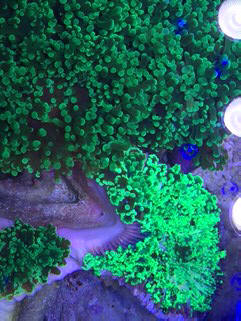 |
Torch coral showing some skeleton
4/6/20
Hi, firstly i hope everyone at WetWeb and their families are ok in these
troubled times.
<Hi Toby, mostly fine, thank you.>
Now to my question to which i cannot really see an answer to on the site
or elsewhere. I have had a torch coral for about 3 months now and it has
looked healthy. Very recently i have spotted when its tentacles are
moving in the current that a part of one side, say 10%, of the coral has
peeled away from the skeleton beneath.
<I see>
The torch coral overall seems healthy, no brown jelly or shrunken
tentacles
<This is a good sign>
the area that is no longer fixed to the skeleton is no different to the
rest of the torch. The skeleton beneath is white and clean. My tank
parameters are stable and other corals are in good health.
<Please send the exact numbers, “stable” is a relative term.>
I suspect i have had this torch in too vigorous a flow which has lifted
one edge off the skeleton.
<Yes, could be just the water flow stressing it out.>
I have relocated the torch to a gentler flow spot where it seems just as
happy.
<Good move>
There was nothing to sting this torch and looking at the skeleton i
don't think this is anything to do with reproductive splitting.
<Me neither>
I have read one or two things suggesting the absence of certain trace
elements can cause heads to detach from skeletons
<Yes, low levels of certain elements like strontium and magnesium can
cause this.>
but my gut feeling is that too strong a flow is the culprit. Do i need
to do anything to help the torch? In the lower flow the detached 10%
area does not lift as it did in the higher flow. Will it reattach? It
certainly should not rip away further if current was doing this. I would
appreciate any advice,
thanks for your time,
Toby
<I suggest checking the mentioned elements just to discard the
possibility that they are below the required levels, other than that, I
would leave the torch on the new location and watch it closely for the
next few days. Cheers. Wil.>
|
Mystery hitchhikers on my frogspawn
2/10/17
Hello WWM crew!
<Kevin>
I was referred here from Bayou Reef keepers by Jordan Stari.
<Ahh! Hi to Jordan. Hope to catch up with him at this year's MACNA there>
He recommended that I post this query specifically directed toward Lynn Z
since she’s the invert expert. I have a mystery beastie on the base of two
of my branching frogspawn heads. When they first showed up, they were so
small I could barely tell they were something other than part of the coral.
Then I started noticing they had kind of a corkscrew antennae or
some other protrusion. I thought they might be some kind of
Nudibranch, but even with a magnifying glass, it was difficult to pick out
any distinguishing characteristics. I searched every site and message board
I could find to no avail. They are right at the boundary between the soft
tissue and the skeleton of each head and seem to retract into the soft
tissue if I shine a light on them for more than a few seconds. When I got
home from work today, one of them had come out far enough that it was ~1/2 –
3/4” long. I took some pictures, but only one of them is small enough in
file size to comply with WWM picture requirements and it is hard to see
anything on that one. I have attached it as a first look. If it’s okay, I
would like to post the best quality picture that shows it pretty well.
Please let me know if that is ok.
<Yes; though; I don't see what you're referring to. Lynn?>
I have had these corals for about two months and they have grown probably
2-3 times the size they were when I got
them in that time. Two of the heads have begun to split. Until about 4 days
ago, all seemed to be well. All of the corals in the tank have been given a
10 minute CoralRx Pro dip before being placed in the tank. I’m thinking that
since they emerged from within the soft tissue, maybe they were there from
the beginning and survived the dip.
In the pic, the dark vertical shape on the left is the branch of the
skeleton. The offending beastie is the whitish thing running parallel to the
branch (it is roughly ½-3/4” in length). As I said, I have better pics, but
did not want to run afoul of the posting rules.
<Do post elsewhere on the Net and send along links please>
Please let me know if you know what this is, whether I should worry about
it, and how I can get rid of it if necessary.
<Like grading school papers, "When in doubt, count it out", I'd vacuum,
remove this>
Thanks in advance for the help!
Kevin Drane
<Have sent on to LynnZ for her input. Bob Fenner>
|
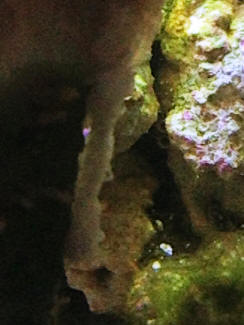
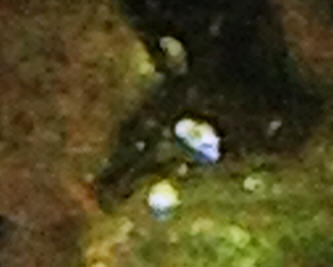 crop...
crop...
|
Re: Mystery hitchhikers on my frogspawn - 2/11/2017
Thanks for the quick response. I have a couple of pics posted on the Bayou
Reefkeeping forum. Here's a link:
Euphyllia eating Nudis?
<http://www.bayoureefkeeping.com/forums/topic/16109-euphyllia-eating-nudis/#comment-191958>
<Mmm; the little white bits right? I don't see rhinophores, gills on these...
Look more like Scutus... a snail on what little I make out... white shells
(could be overgrown), and black feet... No way for you to remove, shoot and send
a better close up pic?>
It seems to be hiding within the soft tissue of the coral because there are
times when you can't see it at all and then it just appears. Thanks again for
the help!
<The better pic please. Bob Fenner>
|
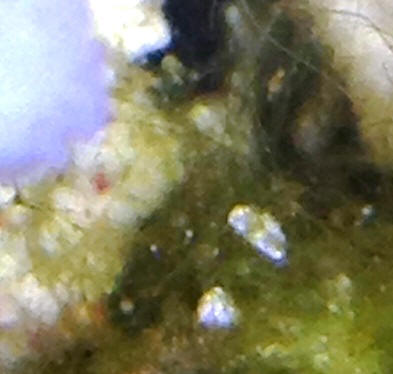 |
|
Re: Mystery hitchhikers on my frogspawn - 2/11/2017
Actually, the long white thing that is extending down from the base of the soft
tissue is one organism. The white bits are part of it.
<Don't see it mate>
There is no shell and it's all white. While it was extended out like that last
night, I tried to suck it out with a turkey baster and it held fast. I then
tried grab it with some tweezers and it still wouldn't come loose. It ended up
breaking in two. The part that was still attached retracted up into the coral's
soft tissue and I haven't seen it since. The part that broke off
kind of fell apart and the pieces were very small helical bits maybe 2-3 mm
long. My fire fish ate ended up eating the pieces. Now I'm worried that it is
going to die inside the soft tissue and as it rots will poison the coral. I'm
debating whether I want to break the heads free from the rock and dipping them
with Bayer.
<Have you considered fragging this colony? I might. B>
Re: Mystery hitchhikers on my frogspawn - 2/11/2017
Thanks for the quick response.
<<Hi Kevin and Bob. Sorry I’m a late arrival on this topic!>>
I have a couple of pics posted on the Bayou Reefkeeping forum. Here's a link:
Euphyllia eating Nudis?
http://www.bayoureefkeeping.com/forums/topic/16109-euphyllia-eating-nudis/#comment-191958
<Mmm; the little white bits right? I don't see rhinophores, gills on these...
Look more like Scutus... a snail on what little I make out...white shells (could
be overgrown), and black feet... No way for you to remove, shoot and send a
better close up pic?>
<<Unfortunately, I can’t see enough detail in the photos to determine exactly
what the subject is either. Offhand, it looks like a typical looping mass of
Cerith snail eggs - I’ve seen these before on Euphyllids. Please see the
following link for an example (bear in mind that these looping masses can be
variably arranged): http://www.nano-reef.com/topic/270550-whats-on-my-frogspawn/
. Do you have any of these snails in your system? If so, and this is an egg
mass, the multitude of loops should start breaking up and detaching within a few
days.>>
It seems to be hiding within the soft tissue of the coral because there are
times when you can't see it at all and then it just appears.
<<If this is an egg mass, perhaps it’s acting as an irritant? Honestly, I’m not
a coral expert so I’m not sure if it’s possible for the soft tissue on a
euphyllid’s stalk to react by trying to alternately envelop then repel an
irritant.>>
Thanks again for the help!
<The better pic please. Bob Fenner>
<<You’re very welcome. I just wish I could have given you a concrete answer.
Ditto what Bob said regarding a photo (if possible!). Take care, Lynn Zurik>>
<Thank you Lynn. B>
Re: Mystery hitchhikers on my frogspawn: Mesenterial Filaments -
2/11/2017
<Greetings, Kevin>
I do not have any Cerith snails
<There goes that theory! On the plus-side, I believe I have an answer for you.>
and I've never seen snail eggs move around like this.
<No, any movement would have to have been caused by something else: water
current, hatching individuals, instability/movement of whatever the mass was
deposited upon, or perhaps a critter of some sort wriggling about inside the
mass.>
Unfortunately, I can't get another picture because after I tried to pull
it off, it retracted back up into the soft tissue of the coral.
<Yep, this is normal (see below).>
There is no question in my mind that it is some kind of separate organism. I
have posted another picture to the forum- this time with annotation.
<Yes, I see – thanks. After thinking about this a bit more this morning, I
started wondering if what we were seeing was simply part of the coral itself,
and that was the ticket. All those loopy structures (that look like guts) did
indeed come from inside the coral. They’re mesenterial filaments
that, thanks to stinging cells/nematocysts, are used to capture/digest, as well
as fight off any threat/intrusion into a coral’s “space”. It could be that the
coral detected a threat (physical or chemical), and deployed the filaments. I
see a small collection of vermetid gastropods to the left of the filaments that
may be at least part of the issue. Vermetids send out sticky strands to catch
food particles that drift by. Those strands could be contacting the coral’s soft
tissue and irritating it. I ran across a photo at WWM that looks very similar:
http://www.wetwebmedia.com/carydisf7.htm . Please see the query at
the bottom of the page titled “Worm infestation… no -12/28/2007”, as well as a
WWM search for mesenterial filaments, Vermetids.>
I appreciate the time you have spent trying to help me.
<No problem, I hope this helps. By the way, if you decide to get rid of the
Vermetids, you can do so my either breaking them off with tweezers at the base
(do not use bare hands – the tubes are brittle and very sharp!), or seal the
tube openings with some gel-type Cyano glue.>
Hopefully the new picture will help you see it better.
<I think we’re good to go! Take care, Lynn Zurik>
Thank you Lynn. B <Always a pleasure, Bob!>
Follow-up Re: Mystery hitchhikers on my frogspawn: Mesenterial Filaments -
2/11/2017
Awesome! Thanks for the diagnosis.
<You are most welcome.>
Jordan was right that you know your stuff.
<Well, we all learned something this time! All I knew was that things weren’t
adding up, critter-wise, so I followed a hunch and it paid off.>
You just saved the coral from the trauma of being broken off the rock and dipped
again.
<Good>
I just knew it was some kind of parasite.
<I can certainly understand why.>
Unfortunately, in my haste to keep a parasite from harming my coral, I tore some
of its mesentery trying to remove it. Hopefully it recovers!
<I would think so.>
It all makes perfect sense now that I put all the pieces together. They had
(very small) Vermetids on them when I bought them as frags. The coral and the
Vermetids have both grown considerably since I got them.
<Yay, regarding the coral! As for the Vermetids, they thrive/multiply in high
nutrient conditions so do keep an eye on this. Same goes for what appears to be
some Spionid or Chaetopterid worms to the right of the mesenterial filaments. In
silhouette, you can see a number of paired feeding tentacles (“palps”). Although
not visible in the photo, these palps extend from hardened mucus tubes covered
with sand grains, bits of substrate, and/or shell. These worms are typically
harmless/beneficial particulate feeders/detritivores but when numerous can
irritate corals, particularly Zoanthids.>
In the last couple weeks, the coral has not been extending as much as it had
been. Now I realize it was due to the Vermetids growing as much as they have. I
will try scraping them off now that I know they are causing irritation.
<Good idea. Just be careful. You do not want to get a nasty infection after
cutting yourself on those sharp little shells!>
Thanks again!
<It was a pleasure! Take care, Lynn Zurik>
|
|
|
Torch coral help? 10/27/16
Hello WWM crew,
I recently purchased a Torch Coral and just now noticed some skeleton
exposed at night. So I flipped the lights on and did a visual inspection. I
can't see any brown decay but I'm still worried about Brown Jelly Disease.
The head in question is the one on the far right.
My levels are:
Mg-1300ppm
Alk-7.3dkh
Phos-0ppm
<Ahh; all life needs "some" soluble/useful HPO4... and NO3. See, as
in read on WWM re. MANY people have been misled by chemical filtrant sellers
on this issue. Your system may simply be too sterile chemically to support
this life>
Ca-440
Ph-8.2
Temp-26 Celsius
Salinity-1.025
Gallons-75
Current stock:
Diamond Watchman
Barnacle Blenny
Snails (turbo tophats and Nassarius)
Hermits (dwarf zebra, electric blue)
Leather (toadstool)
Photosynthetic gorgonian
Mushroom
<Other usual "causes" include (other) environmental issues... too
much/little of something necessary (physical, chemical, biological);
predation/harassment (perhaps the hermits here), Allelopathy (maybe the
Sarcophyton, Shrooms...>
It has just been only 2 days since I bought the Torch but any help
would be much appreciated.
<Oh, or just general stress... moving is VERY stressful. See WWM re the use
of iodide-ate (I'd triple dose the system, then three days later, double
dose), the possible use/administration of simple sugar. Write back after
reading if your course of action, and rationale aren't clear. Bob Fenner>
Thanks!
Kellan
|
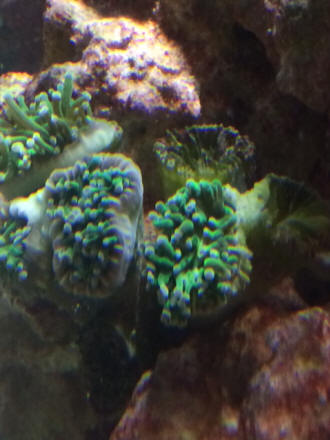 Re: Torch coral help?
10/28/16
Hey there (once again),
Thanks for the help it really is greatly appreciated. Concerning the iodide-ate,
is it the iodine supplement dosed in the reef tank on a weekly basis. Or is it
the iodine dip used to disinfect?
<They are all the same here>
One last question. What is the sugar supposed to do? (Is it for the same purpose
as carbon dosing?)
<Gets into the animals bloodstream... a source of simple nutrient>
Thanks again!
Kellan
<Welcome. BobF>
|
Black stalk on Hammerhead corals
8/15/16
I haven't written for a long time and tried to find my answer on your website
but finally gave up. It's a strange question, I think!
I have three hammerhead corals in my 90 g. marine tank and something weird has
recently happened. I've had the coral for about a year and all was well until
now. The trunks/stalks/or whatever they are called have suddenly turn from white
to black. They seem to be in good health otherwise.
<Have seen this happen before... metabolic? Some sort of overgrowth?
Doesn't seem to be debilitating... and does occur in the wild as well.>
The 90 g tank is about eight years old, has two clowns, one blue-green Chromis,
four small pajama cardinals, one orange-spot goby, a Coral Beauty angel, and a
Royal Gramma. Also, two cleaner shrimp and three peppermints (friendly, not
nocturnal!), and three snails. The parameters are temp. 76 degrees, ph 8.4, no
ammonia or nitrites, nitrates now at 2, phosphates 1.5,
<? ppm?>
calcium 495
<I'd let this drift to the low 400s>
dKH, alk now at 6-5 to 6.7. I have added 1 1/2 to 2 teaspoons Seachem Reef
Builder twice a week after testing, but not at the same time as water changes. I
mention this because I do a 5% water change twice a week per suggestion from one
of your crew. I have a sump and a Eshopps protein skimmer (don't like, but can't
afford a better one).
<This one's fine>
Since adding the Reef Builder the hammerheads have turned from white trunks and
stems to black. Is this normal?
<As stated, not abnormal>
Should I stop the additive?
<What else would you use to sustain alkaline earths, alkalinity? I wouldn't
stop>
I can send a photo if you think that is needed.
<Mmm; if you'd like>
Any help you can give me would be really appreciated!
Edie
<Really don't think there is a need for help here. I would continue as you are
doing. Bob Fenner>
Re: Black stalk on Hammerhead corals 8/15/16
Hi Bob, Thanks for such a quick answer! I do appreciate your help so much.
The 495 of calcium I referred to is ppm. (I have several Salifert test kits now
that I really enjoy--so easy and accurate.) The rise in calcium coincided with
the addition of more aragonite sand. I thought my sand bed would be better if it
were a little deeper, so added about 10 lbs. live aragonite sand and mixed it in
well with the original sand. How do I lower the level of calcium now, or does it
just go down on its own over time?
<The latter; just time going by. Not advised to offset this w/ alk. addn.>
I don't have any other product to sustain the alkalinity at a good level, so I
was just wondering if Reef Builder was adequate.
<Should be; yes>
I'll keep testing and add as needed as you suggested. I have your book, "The
Conscientious Marine Aquarist" and refer to it often. Up until a year ago, I had
only FOWLR tanks, so there is still much to learn.
<Oh yes; for me most days bring facts, ideas I'd not considered>
Incidentally, I also want to thank you and your crew for the information on
getting rid of that awful red slime algae (I know, blue-green algae) and added a
third powerhead, rinsed the frozen foods, fed a little less food, continued
frequent water changes, and monitored the protein skimmer daily.
All it well now--that a relief!
<Ahh!>
I don't have a photo of the black, or dark brown, stalks on the hammerheads, but
it sounds like you've answered by question without one.
So thank you once again.
Edie
<Certainly welcome Edie. Cheers, Bob Fenner>
Re: Black stalk on Hammerhead corals 8/15/16
This seems to have come back to me---I hope I'm not duplicating my previous
message. Edie
<Thank you for re-sending. B>
Euphyllias... hlth.
6/13/16
Thank you. I notice something odd. The hammers in my 265 for the most
part are doing well. Their heads get larger and the babies double their
sizes in about 3 days. But there are few heads on the side that
keep dying like the big heads are competing causing their demise?
<Possible... I encourage you to review the FAQs archived on WWM re this
family's compatibility and health. Solutions frequently sought include
the use of chemical filtrants, ozone.... moving the considered
offender/s,
offendees... fragging... Bob Fenner>
Please help. Cnid. allelopathy in a new, large sys.
5/26/16
Hello Mr. Fenner,
<Hey Dai>
I hope you can point me in the right direction. I have a 265 gallon reef
tank that I set up 4 months ago. I have sump/refugium, 4" carbon
reactor, 6" media reactor with media pellets, 8" skimmer. Lights are 4 Hydra 26
HDs.
Nitrate /phosphate is zero
<Mmm; stop here: You know that all bio-mineralizing life requires "some" NO3 and
HPO4? W/o these basic chemical nutrients all your "corals" will be very
stressed/starved>
and the water is within reef parameters. The tank has 3 sections. Left
is Zoas, center is 100 plus heads of hammers/frogspawn, and the right is 18"
green leather and 4" green toadstool.
<Yeeikes....>
Everything was fine with Zoas multiplying, hammers sprouts tiny babies but
within the past 5 days, some of the hammer heads just died leaving stalk
white skeletons.
<The "losers"... to either the Alcyoniids or Zoanthids>
I bought a 60 gallon so this weekend I can put the finger/toadstool in it.
I hook up the FX6 filter (400 GPH) with carbon to address chemical warfare since
Monday. I think the reasons on the demise of the hammers are :
1. Chemical release from leather/toadstool.
<Possibly>
2. Media reactor strips all nitrate/phosphate which hammers do need to grow.
<Definitely a/some factor>
So my plan is:
1. Move the toadstool/green finger to the 60 gallon.
<Okay>
2. Discontinue the FX6.
<All-right>
3. Discontinue the carbon and media reactor (all in one pellets).
<Sounds good>
The Zoas are thriving with new heads forming every week. I love to have a garden
of hammers and while some people grow these like weeds, I can't keep them alive.
Before dying, they thrive then die next day. Is my diagnosis and plan of action
correct? Thank you Mr. Fenner. Dai
<I do agree with your plan; is what I would do, try at this point. IF no
improvement, I would move the Euphyllias elsewhere. DO PLEASE READ AND HEED my
acclimation protocol for introducing any/all NEW Cnidarians... by mixing water
to/fro twixt the main-display and isolation/quarantine system. HERE:
http://www.wetwebmedia.com/CorlCompArt.htm
Bob Fenner>
<<Note: next time mention triple-dosing iodide-ate>>
Re: Please help
Thank you Mr. Fenner. So you are saying maybe it is the Zoas that are affecting
the hammers as well ?
<Might/could well be; yes>
In that case should I move the hammers to the 60 and leave the toadstool/finger
in the main tank?
<Yes; a better plan... Plus I'd triple dose all (both systems) with
iodide-ate... every three days, three times>
Or just leave them in the main tank for now? I bought the 60 for the leathers
specifically. Is it OK to run the 4" carbon reactor?
<Can't say from here. I would NOT use such on a newish system period>
On another topic. I think the" all in one pellets" give people the false sense
of security.
<Oh yeah; the/a "western ethic"... trained to be good consumers... "Buying"
something... but sans understanding, often false notion/s>
The dealer touts as " zero nitrate and zero phosphate" so people go crazy
thinking they don't have to do water for a year. But while this is true, it is
hurting corals because it is stripping of the essential nutrients that corals
need.
<Yes... even other media/sources tout that the world's reefs are "nutrient free"
when in good shape. NOT the case. They are nutrient concentrated; with the life
there scavenging most all available. NEVER zero nutrients in the water>
If you have to rely on these 'miracles" to get nitrate/PO4 to be zero then that
person needs to evaluate his technique of husbandry.
<Very well stated>
Thank you and I look forward to your guidance. Dai
<And I to your further sharing. BobF>
Re: Please help 5/27/16
Ok, so this is the plan. Move the hammers to the 60. How much of new water to
old water ratio be?
<About half>
If the old water is not good (chemical warfare, no nutrients) then may be start
with 100% fresh water?
<Not I>
You talk about triple dose 2 tanks but I am not familiar with the medication.
You mean every three days, I dose the tank 3 times a day and for how long? Is
this the iodine coral dip?
<See WWM re. B>
Thanks! Dai
Re: Please help... Euphyllias, hlth. 6/3/16
Hello Mr. Fenner
<Hey Dai>
The 60 gallon is getting ready as I had to order a new tank. In the mean time my
hammers are dying so I need to get them out of my 265.
<I'd move NOW; with a good deal of their present water>
I have a 50 gallon tank and freshly prepared water (a week old) that I will put
in that tank with 40% old water and 60% new water.
<Oh! Good>
I will move all the hammers into that 50 gallon until the 60 is ready (likely by
this weekend). The 50 just have HOB filters, T5 so do you see any issues with
this plan?
<I do not... I WOULD triple dose w/ iodide/ate after the move... possibly more
as a dip, along w/ a simple (hexose) sugar enroute>
I have run an external filter FX6 (400 GPH) to get rid of the chemical warfare
but the hammers are still dying. Thank you for your reply. Dai
<Cheers! BobF>
|
Brown Jelly Euphyllia paradivisa... actually chem.
starvation, allelopathy... iatrogenic errors 3/16/16
Good Evening,
<And you>
I am looking for your wisdom on saving a large neon Euphyllia paradivisa
from the dreaded brown jelly disease.
This event is spreading quickly so please advise and I will jump into
action.
<Likely expedient>
150 gallon, 6 year established mixed reef, skimmer, LifeReef CO2 reactor
& sump & refugium, LEDs, MP 40s, constant pH 8.06 (due to CO2 reactor?),
<Maybe... What is your RedOx? >
CO2 reactor pH 6.5, no phosphates, no nitrates,
<... all photosynthetic; make that all life requires some measurable
HPO4, NO3... See, as in READ on WWM re>
415 calcium, alkalinity 12 dKH,
magnesium 1300, 1.026 salinity, 80.8 degrees F, 20% water changes
weekly, softies, few SPS, many LPS, 10 fish, hermits, starfish,
snails...
I noticed a small Aiptasia on the disc of a large toadstool leather a
month ago.
<So; in addition to chemical/food starvation, allelopathy may be an
issue>
Yes, I should have addressed it but didn't.
This Sunday, I used a small dab of Aiptasia X on the anemone and noticed
a ring of dead/loose tissue the size of a quarter around the pest.
So I turkey basted up the dead tissue and the melted anemone. When I did
this it revealed a deep tunnel of dead tissue coming from inside the
trunk of the
toadstool. Anyhow, I turkey basted up more dead tissue and then...
proceeded to gently turkey baste the new tunnel through the
toadstool...when
I did this dead tissue spewed into the water column. I turned on the
media reactor
<... what is in this reactor?>
to run carbon and did the 25% water change. Everything looked great in
tank.
Monday, toadstool was still in good recovery.
Tuesday, toadstool looking still positively recovering-the tissue looks
good! Polyps are thinking about opening under the normal shiny slime
coat it gets when it goes through growth spurt. HOWEVER, on the other
side of the 150 gallon tank, I noticed a tiny spot of brown goo on a
hard to see area of a giant Euphyllia, around noon. Hoping it was waste
product, I made a mental note.
At 5:00 p.m., the pea sized brown goo was quarter sized. I rotated the
coral to take a photo and have a clearer view. Yes, it has to be tissue
from the toadstool on the opposite end of the tank landed in the far end
of the frogspawn! What do I do?
<Water changes, chemical filtrant (Polyfilter, GAC) use, and overdosing
of iodide-ate>
This is my prized (6 years with me) neon wall frogspawn. I can't loose
it.
<Or lose it>
Panic is setting in! I have searched the internet and wet web....
Do I try the iodine dipping routine?
<Not dipping, addition>
(I tried this years ago to no avail.)
Do I take it to the LFS with a coral saw to separate infected from good?
(I think this is the only option to save part of this LPS. ?)
<A possibility... but not what I'd do... see the above, use the search
tool (on every page on WWM) and READ>
By tomorrow morning, this could be really bad.
Thanks for any suggestions.
I have learned a painful lesson: turn off power heads when working
around suspicious coral tissue and address pest anemones ASAP.
Sincerely,
Wendy
<And you; Bob Fenner>
|
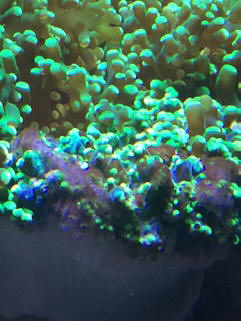
|
|
Euphyllia Brown Jelly
3/16/16
another pic of brown jelly
<This looks more like BGA... do you have a microscope? Same response
otherwise. BobF>
|
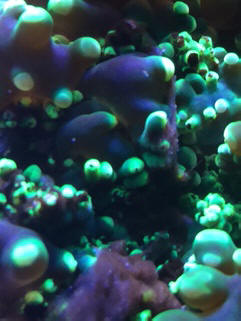 |
|
Toadstool Leather dead tissue
3/16/16
Continued:
Here is a picture of the toadstool with the dead tissue and melted Aiptasia
before I turkey basted up the majority of dead tissue.
The tissue was powdery & fibrous grey. The tissue on the toadstool was not
slimy brown.
But it has to be what started the brown jelly on the frogspawn. ?
<A contributing factor very likely>
Thanks again.
<Allelopathy by Alcyonaceans.... reading. B>
|
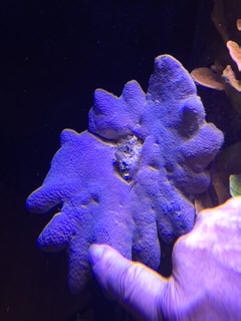
|
Euphyllia Brown Jelly-cautiously optimistic
3/18/16
Hello Bob,
Thank you for your advice! I am cautiously optimistic.
When you mentioned RedOx, I was reminded to learn more about this measurement.
<A VERY useful indicator of a system's capacity to foster life>
Reading through the articles in WetWeb helped me understand its importance. It
will be the next addition to the system.
I did a 25% water change, changed the carbon, changed the poly filter material,
cranked up the skimmer, gently turkey baste away any brown jelly that forms
every couple hours, raised the iodide-ate to .09 overnight, the next morning 20%
water change, more turkey baste removal, iodine level now at .08 and the
frogspawn is looking pretty good!
<In the photo; I agree>
(Tomorrow I will do a 10% water change and work on getting the iodine down to
.07.) The brown jelly production is now minimal and the other 3/4's of the
frogspawn is acting almost normal.
<Great>
(The only coral objecting to the high iodine level is a sunset encrusting
Montipora, other Montiporas are looking fine.)
I have been reading and will continue to read about increasing nitrates and
phosphates. So the goal is NO3 a few ppm and HPO4 between .01-.05?
<Yes>
I looked back into the log, and Nitrates ranged between 0 - .2 (Salifert), and
Phosphates ranged between 0 - .04 (Hanna & Red Sea) over the past 6 months. Most
of the time the readings were 0, which is strange when the
refugium is full of macroalgae,
<Ah, not strange... the algae are/were scavenging most all>
fish are generously fed, I target feed corals, corals are growing, and
occasionally tank has a minor hair algae event.
<I'd remove a good deal of the 'fuge macro-algae... only run the 'fuge lighting
at night; in opposition to the main/displays>
A Neptune Apex was recently installed, so the next programming I will do is to
turn off the skimmer during feeding...and night?
<I'd leave running at night; for DO>
and add the ORP probe.
Anyhow, thank you for the recommendations and hopefully this wall Euphyllia will
pull through. I feel that it was in a thriving state of health before this event
due to its tripling in size over the past 6 years, great polyp extension and
good fleshy tissue around the calcified base.
Reading, reading, reading is the only way I have gotten this far in the
hobby...the chemistry part isn't natural for this art major. Thank you for
trusted advice.
Sincerely,
Wendy
<Your response, success... is exactly what I hope for in producing and making
WWM available. Thank you for sharing.
Bob Fenner>
|
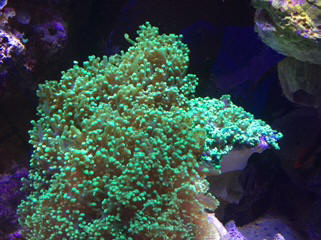
 |
|
Diatoms, Phosguard and photo period; plus Euphyllia env. loss f'
2/23/16
Hello all and thank you for the kind service you do for us in the hobby.
<Hope to be helpful!>
I have had my 60 gallon reef tank since September 2011. For many years I ran a
Marineland reef capable led light. I loved it. Eventually some leds began
shorting out and I replaced it with a Kessil 350 led.
<Excellent product.>
After 8 months the Kessil stopped working.
<Uh oh! Any idea why or what specifically went wrong? I'd have looked into
getting this fixed, it should be under warranty and in any case, failure like
this is both uncommon and unacceptable with a light of that build and price.>
I went without a light for a month or two and lost my hammer coral.
<And probably a lot of other organisms great and small, certainly. What else was
in there? And did it get window/external light? Did you feed the tank?>
I then bought another Marineland reef capable 48" led fixture and put it on my
tank. Here is my issue now; I got a horrible diatom outbreak right away. I tried
decreasing the photo period from 8 hours to 6 hours and then to 4 but nothing
helped. My sand and my rocks were covered with horrible powdery brown growth. I
tested my r/o water with a tds meter and discovered I needed new filters. I
ordered these and began using purchased r/o water that tests ok in the meantime.
I rinsed my rocks in old tank water and did a 15% water change and kept the
light off for a week and started running Phosguard Saturday. My tank looks
amazing again. Can I put my light back on? Will I get another outbreak? Was it
my water? I'm so confused and unsure what made the positive difference, the lack
of light or the Phosguard. I appreciate any insight.
Thank you for your time,
Sarah
<Well this is certainly a combination of factors but can be boiled down
to "nutrients" from die-off, possibly your source water as well, lack of water
changes, disrupted biological filtration. All these will cause all
sorts of nuisances to crop up. Your best weapon here is simply more
frequent/larger water changes. Say 20% a week. This will get things back on
track, especially alongside the Phosguard and good ro/di water. If it were me I
would set the light up normally; diatoms/slime algae and their ilk love
low-flow, "dirty" water and usually, low lighting. There's no mystery or trick
here, just keep up your water quality with water changes, keep the tank as
stable as possible, under stock it for a while and don't feed any more than you
need to. Then go from there. As you have seen, coral is known to be "fragile"
but it often surprisingly tough! Anything that survived
this disaster is likely to do great again if you stick to the above concepts.
-Earl>
Re: Diatoms, Phosguard and photo period
I also want to add I run a reef octopus hang on the back skimmer that produces
maybe half a cup of dark skim a day.
<Excellent! Invaluable tool and it seems like you have it tuned in well.>
Re: Diatoms, Phosguard and photo period
2/28/16
> Thank you for your quick and insightful reply. I emailed Kessil last week
> and they gave me some troubleshooting which has done nothing. I need to
> follow up as I think she needs my receipt. It was very pricey and I'm still
> in shock it broke. My tank is next to a bank of 3 north facing windows so
> my fish still had a photo period and the blue mushrooms have doubled in
> number.
<Ah north light windows, beloved by painters! Cooler light (towards the blue end
of the spectrum), may have had an effect on your tank perhaps. Better than warm
yellow light, certainly.>
> Not worth losing my hammer though. I continued to feed my 4 fish
> yes. At your advice I resumed using my MarineLand light 2 days ago at
the
> preset timer, I think it's 8 hours on. I will do a 20% water change as you
> advised this weekend. My sandbed is clear, no diatoms. Thank you for your
> support and kindness. It's a lonely feeling to flounder and struggle in
> this hobby and nice to have knowledgeable people to turn to mitigate this
> feeling.
> Have a wonderful day,
> Sarah
<Thank you for the kind words, glad to be of use. No need to feel alone in the
fish n' coral keeping hobby though! I cannot overstress how great it is to join
a local aquarium club (they are just about everywhere). Also try social groups
online. There is a Ladies' Frag Swap Facebook group my better half frequents
that might interest you, as a suggestion. Remember, slow down, enjoy, don't let
up trying to get that Kessil replaced/repaired, and maybe sell some of those
blue 'Shrooms or trade them...get some new hammer frags :)>
Question re: Branching Euphyllia dying 2/22/16
Hello WWM!
<Hey Cath>
Thank you in advance for all your advice and help. It's such a wonderful
resource for us new aquarists. I'm having some serious troubles with one of my
corals and none of my coral books have been able to provide a clear answer.
Some background, I have a 72G w/ 20G sump (with refugium), running now for
almost 9 months old. I have 1 torch Euphyllia, 1 branching Euphyllia, 1
hammerhead Euphyllia and 1 leather A. Sinularia. Also a small Ricordea that
arrived with the live rock. All are fairly spaced out with at least 6-8 inches
between them. For fish I have a watchman goby + pistol shrimp, 3 Banggai
cardinals, 1 Firefish, 2 clownfish & 2 cleaner shrimp.
Up until 2 months ago, everything was going along perfectly with really no
issues, corals were looking healthy and I'd had nothing die beyond the
occasional snail or hermit crab. The problems began when I took a holiday over
Christmas and the tank went almost 6 weeks with almost no maintenance.
I came back to a tank that had a variety of macroalgae taking over the
live-rock. A couple weeks ago I started again with my typical 10G water changes.
Then last Tuesday I noticed my torch euphellyia had lost 2 out of 6 of
it's branches (the polyps had seemingly disappeared overnight and left
the calcified stumps behind). On Thursday the remaining branches looked worse
for wear and so I did another water change of 10G and checked all the water
parameters.
<Then; or now; I'd be double, triple dosing w/ iodide-ate>
Nitrates/nitrites and ammonia all basically zero.
<Ahh, need some N, P, K....>
By yesterday one more branch's polyps are shrunken right to the base and what
looked like a piece of dead polyp hanging off it, a second branch is looking
darker and more retracted with the last two branches still looking healthy. The
other corals look fine and no different than usual.
My question is should I cut off the dead/dying branches to try to save the last
normal branches if it is in fact some kind of infection?
<I'd leave all in place. The way Euphyllias (Caryophyllid, Euphylliids) "work"
is that the various branches are autonomous... one dying won't necessarily
mal-affect the remaining>
Should I be turning down the lights in case the coral is struggling from a
sudden light shock? I can't think of what else it could be because nothing else
has changed as far as temperature, salinity or nutrient dosing (I do only
occasional Ca). No new creatures have been introduced - the clownfish and
hammerhead Euphyllia were the last to be added in November.
Thank you thank you!
Catherine
<I would step up the fish et al. feeding to where you can register some
NO3.... or more dangerously add a complete "coral" fertilizer that will do
this... I'd also be using GAC in your filter/flow path... Do you have means of
measuring RedOx? Bob Fenner>
|
|

